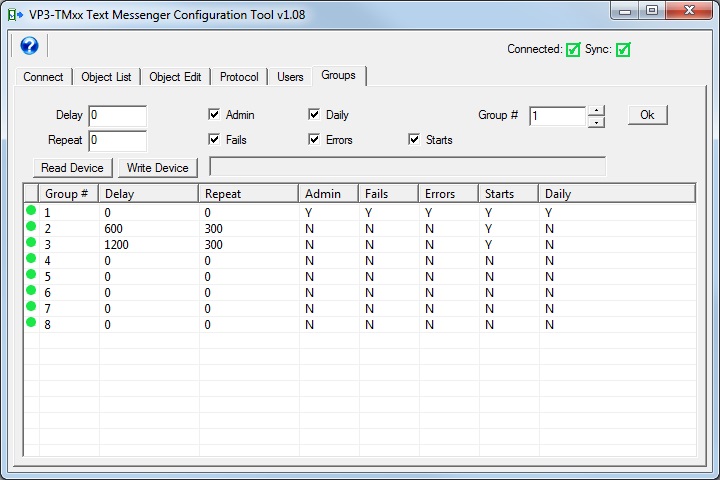


Configured similar to objects, user group definitions start with an identifier, delimited with a space, and the first element following is the group number. Configuration fields follow. For example:
group 1,delay=3600,repeat=300,admin=yes,fails=yes,errors=yes,starts=yes,summary=yes
The parameters available for configuring the group are:
group 1,delay=3600
group 1,repeat=300
Sets delay and repeat times in seconds for group. The delay will postpone notification. If an alarm is resolved before the delay expires, then this group would not be notified. If an alarm requires acknowledgement and is not acknowledged before the repeat time expires, then the notification will be repeated.
NOTE: If a user is included in two groups, and the second group has a delay applied, then that user will receive the same message twice with the second time being after the delay.
NOTE: Only those SMS numbers receiving an alarm active notification will receive the corresponding alarm inactive notification. If the report delay resulted in an SMS number not receiving the active notification, then that number will also not receive the inactive notification.
group 1,admin=yes
Send message to this group any time a new user is added, or user configuration is changed. Admin will also receive a message when a user replies “stop” to their messages, or if messages are stopped automatically due to excessive errors attempting to send to that user. The admin group will also receive a notification if the password is changed by another user.
group 1,fails=yes
Send message to this group any time an object goes into default mode. The object’s defaultonfail must be set for this to happen. The default will be set upon reliability code transitioning from zero to non-zero.
group 1,errors=yes
Sends message to this group any time an object’s reliability code transitions from zero to non-zero.
NOTE: To clarify, errors=yes will report all objects transitioning from reliability code of zero (no faults) to non-zero (fault of some kind). Whether the fault results in the object being set to the default value depends on the object’s “defaultonfail” setting. If the fault that would otherwise be reported as an error results in the object being set to its default value, then the same fault will be reported as a failure instead (fails=yes). If errors are not being reported but failures are being reported (errors=no,fails=yes), then only those faults resulting in an object being set to its default value as a result of the fault will be reported via SMS.
NOTE: Reliability is status value normally used for BACnet, but is also used for Modbus in the VP3-TM in order to report errors object by object. This is especially important for tracking down exception errors. CRC errors are general and usually related to wiring, so are not important to report by device. But exceptions are very object specific.
group 1,starts=yes
Sends message to this group every time the device restarts.
group 1,summary=yes
Results in a daily summary report being sent to this group. The timing of the daily summary is tied to the 24-hour timer used to send daily object reports (objn,reportdaily=yes). The 24-hour timer is maintained for other daily reporting purposes even if no object has its reportdaily option set. The daily summary includes the site name, count of objects (points) monitored, count of active alarms, and count of objects with errors (most often communication problems).
Copyright © 2019 Control Solutions Minnesota, Inc.